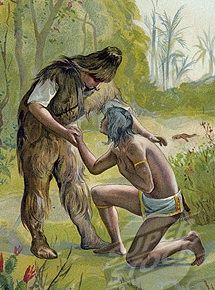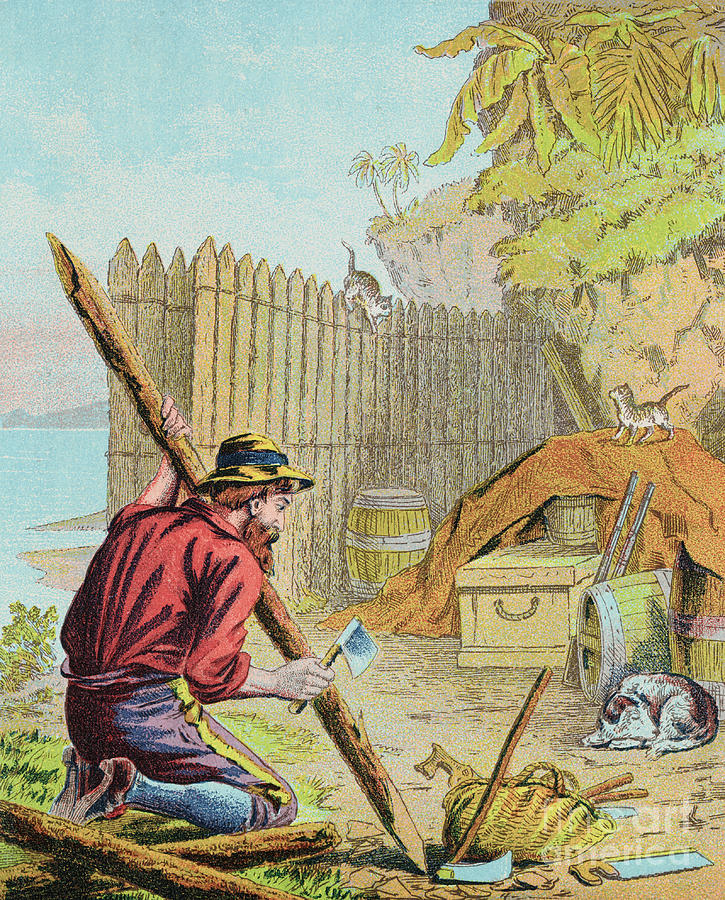Born in York
A retired German merchant named Kreutznaer (Kroitzner) settles in the York country where, due to the “usual corruption of words in England,” the German name becomes Crusoe. In York, Mr. Crusoe marries a woman whose surname is Robinson.
Later, Robinson Crusoe, born in 1632, is their third child. Early on, Crusoe’s father determines that his son will become a lawyer. Unfortunately, Crusoe “would be satisfied with nothing but going to sea.” His mother and father do not allow it.
To London and Trade
A year later Crusoe sneaks away and accepts passage to London. He leaves on September 1, 1651. During a terrible storm, he promises to return home to his parents. Yet after the ship sinks, he forgets his promise. Instead, he goes to London and befriends the captain of a vessel bound for Guinea. He joins the voyage.
After the successful voyage, Crusoe makes yet another journey with his friend. Even after his friend suddenly dies, he gives most of his money to his widow and buys trade goods then takes the same ship for another voyage. On the way to Guinea, Moorish pirates seize the ship and he is forced to become a slave.
Two years later, Crusoe escapes in a fishing boat with the slave boy Xury. They sail down the “Barbarian Coast” of West Africa. Finally, just off the Cape Verde Islands, a Portuguese ship bound for Brazil rescues them. With Xury’s consent, he sells him along with the boat’s inventory to the ship’s master.
Deciding to make his fortune in the area, Crusoe purchases a slave and a Brazilian sugar plantation. He enjoys moderate success with the new venture. A bit restless, he becomes interested in leading a slave expedition to Africa. So, at the “evil hour, the 1st of September, 1659,” he embarks for Guinea; tragically, a hurricane wrecks the ship and only Crusoe survives.

“The Island of Despair”
Crusoe is shocked to find himself on the deserted island. His undergoes different kinds of psychological troubles, paranoia, and fear. Later, he falls asleep. Crusoe spends several days searching for essentials in and outside of the wrecked ship. He establishes a fort which he calls his “castle”, where he brings up a dog, some cats, and a parrot. He keeps a record of time, but after his ink runs out, he cannot maintain his journal.
Reviewing his life, he realizes that he has been selfish and cruel. He repents and resolves to lead a virtuous life. His days are filled with exploring the island, improving his castle, domesticating goats, experimenting with different dishes and developing other skills necessary for self-sufficiency. Having secured shelter and food, Crusoe makes a boat. He constructs a small one and uses the boat only for transportation to other parts of the island.
After twelve years, Crusoe finds the print of a man’s naked foot on the shore. His mind becomes unsettled but be manages his fear. He also discovers human bones and signs of cannibalism. Eleven years later, he finds A Spanish ship wrecks off the coast and Crusoe is able to save some provisions from the wreck.
The End of Solitude
One night, in his twenty-fourth year on the island, he dreams of saving one of the cannibals and civilizing him. Eighteen months later, on a Friday, his dream comes true. The savage falls at Crusoe’s feet out of gratitude. Crusoe calls him Friday, and teaches him important English words like “Master,” “Yes,” and “No.” Gradually, Friday becomes civilized, converts to Christianity, and adopts English habits. Friday tells Crusoe about the Spanish castaways living with his tribe on the mainland. Crusoe begins work on a bigger boat to bring the Spaniards to his island.
![Friday's first interview with Robinson Crusoe" [Plate 7] — Illustrated Edition of "Robinson Crusoe" (1818)](https://victorianweb.org/art/illustration/crusoe/8.jpg)


In the twenty-seventh year, cannibals attack Friday’s tribe (along with a few of their captives). One of the captives is a European, so Crusoe and Friday attack back the cannibals to free the captives: Crusoe shoots several of them and the rest of the cannibals flee. One of the captives turns out to be Friday’s father. With the support and help of the tribes, Crusoe expands his agricultural production. On the condition that they accept Crusoe’s leadership, the Spaniard and Friday’s father leave to fetch the rest of the Spaniards. Meanwhile, a group of English sailors (mutineers) land on the island to dispose of their captain and his loyal officers. Crusoe and Friday rescue them, capture the sailors and take back the ship. The sailors choose to stay on the island as Crusoe’s subjects rather than return for punishment in England. Crusoe takes Friday to England along with the rescued English captain.
Back to Civilization
After an absence of twenty-eight years, Crusoe returns London in June, 1687. After the English captain gives him a reward, Crusoe learns that his parents are dead. Crusoe discovers that he is rich because of some previous investments. After rewarding those who served him faithfully and selling his plantation, he returns to London. Back in London, he marries and fathers three children. After his wife dies, he embarks on a final journey. On the way back, he visits his colony, which is flourishing.




Critical analysis
Robinson Crusoe is a fictional autobiography written from a first-person point of view, apparently written by an old man looking back on his life. The story also includes extractions from an incomplete diary, which is integrated into the novel.
Defoe’s use of realism, or verisimilitude, is perhaps the most singular aspect of the work. What Defoe did was apply and thereby popularize modern realism. Modern realism, as formulated by Descartes and Locke holds the view that truth should be discovered at the individual level by verification of the senses. The realistic elements of Robinson Crusoe include the lists, time scale, repetition, diary, and Crusoe’s ordinary nature. The reader could almost use Robinson Crusoe as a handbook if ever stuck on a deserted island. Many critics view Robinson Crusoe as an allegory for Defoe’s life.
Sir Walter Scott (father of historical fiction), the leading advocate of verisimilitude in the early nineteenth century, praised the work for its realism. Scott also noted the tremendous impact it had on boys who go to sea for the first time. In the second half of the nineteenth century, scholars began a debate to the real identity of Robinson Crusoe. Thomas Wright proposed that the character of Robinson Crusoe is based on Alexander Selkirk (a Scottish navy officer).
James Joyce explored the colonialist theme of Robinson Crusoe as early as 1911, his comments were not published until 1964. Since then, writers such as Toni Morrison, Derek Walcott, and Edward Said have viewed the novel as an allegory of colonialism.
Previous University question?
1. 1. How does Defoe reveals the project of colonialism in the novel Robinson Crusoe?
2. 2. Elements of realism in Robinson Crusoe?
3. 3. Relationship between Robinson Crusoe and Friday?
4. 4.Ideas of travel, trade and colonialism in Robinson Crusoe?
5. Comment about the theme of slavery?
No comments:
Post a Comment
looking forward your feedbacks in the comment box.